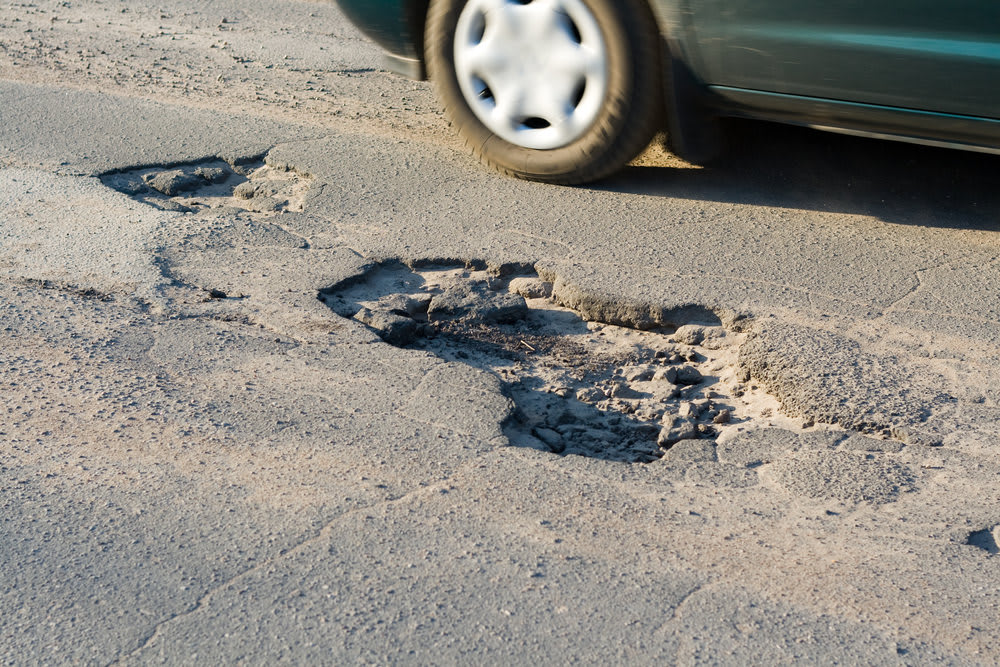

Every car, truck and SUV features a suspension, the system of parts that holds the vehicle up, absorbs bumps, and allows it to steer. For the most part these systems wear out slowly, and with proper maintenance and periodic inspection they can be expected to experience only small, incremental problems. However, occasionally a suspension will fail suddenly and dramatically and the vehicle will in effect fall down — sometimes a couple of inches, until metal touches metal, and sometimes all the way only one or more wheels. This sort of sudden failure results when a spring or other weight-bearing part breaks, and is referred to as a collapse.
Luckily, suspension collapses are quite rare. Most vehicles sold today feature coil (spiral) springs, which on average have around a 1 in 1000 chance per year of breaking. Older vehicles with leaf springs may be somewhat more subject to suspension collapse, but it’s not to be expected on any vehicle.
However, spring collapse does happen and there are even indications that it may be becoming more common. Several factors can contribute to spring collapse:
Bumps: Most spring collapses occur when the car or truck hits a bump, but it takes a very large or high-speed bump to break a normal, healthy spring.
Overloading: A spring that is greatly overloaded can break, but as with bumps, it takes greatly excessive load, usually far in excess of the vehicle’s load rating, to break a typical automotive spring that’s in good condition.
Rust: Almost all automotive springs are made of steel, and all steel rusts to some extent. Rust and other corrosion is the combination of a metal (such as the iron that forms the basis of steel) with oxygen from the atmosphere. Corrosion greatly weakens steel, rendering the springs much more subject to collapse. Salt, particularly the salts used on roads in snowy areas, greatly increases the rate at which steel rusts.
Other chemical changes: Metals such as steel can experience other chemical changes over time. For example, hydrogen molecules can penetrate between the iron that composes steel, making it more prone to cracking; this is called hydrogen embrittlement. Like corrosion, hydrogen embrittlement is caused by the presence of road salt on the spring.
Age: Metal doesn’t simply weaken over time, but repeated bending (including from vibration) can eventually cause cracks, weakening a spring. In general it takes many millions of bends to weaken a steel part significantly but the process is accelerated by rust and the other chemical changes mentioned above. And of course, rusting and other chemical processes take place over time, so in general an older spring will be weaker than a younger one.
With these factors in mind, we can see what would tend to cause spring collapse in the real world. A new spring shouldn’t collapse unless the car or truck is abused with a very heavy load (much more than it was designed for) or very hard bumps such as hitting potholes or speed bumps at high speeds. However, an older vehicle will be somewhat more likely to experience spring collapse under a load or over bumps.
The most important cause of spring collapse is weakening due to the chemical actions of salt. The salty air in seaside areas may tend to accelerate these processes, but for the most part the problem is road salt. Spring collapse is more common than average in the snow belt and is several times more common in winter, when roads in much of the country are routinely sprinkled with salt to melt ice, than it is in summer.
Why might corrosion be leading to increasingly common spring collapse today? Road salt has been used for many years, so that’s probably not the reason for an increase. The most likely cause is that with the rise in fuel consciousness, vehicle manufacturers are always looking for ways to make cars and trucks lighter; suspension designs now include thinner springs, because thinner means lighter. And because corrosion and hydrogen embrittlement start at the surface of the spring, a thinner spring will be affected more quickly than a thicker one.
How to prevent spring collapse
The most important thing: in snow country, frequently rinse off the underside of any vehicle that drives on salted roads. Be sure to wash up in the wheel wells, where most springs are located. The longer salt gets to stay on the springs the more chemical damage it can do, and the more damage, the more the springs are weakened.
Regardless where you are, don’t carry loads that are much heavier than your vehicle was built for.
Avoid hitting potholes whenever possible (for this and other reasons), and try to slow down over very large bumps such as driveway openings and speed bumps.
Finally, what should you do if your car does experience spring collapse? First, don’t panic; collapse is dramatic but the car will still drive. But do understand that driving a car with a broken spring is quite dangerous. Slowly pull to the side of the road as soon as you safely can; after you’re safely out of traffic, have the car towed. If you absolutely must drive a vehicle with a broken spring, understand that it will handle very poorly especially in an emergency; go as slowly and carefully as possible.
Luckily it’s usually straightforward to replace a broken spring, so you’ll soon be on your way again.



